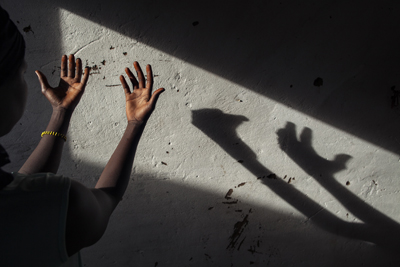
DAVID ADAMS reports…
About one in 10 girls globally have been forced into sexual acts while a fifth of all homicide victims in the world are aged under 20, according to a landmark report issued last week.
UNICEF’s Hidden in Plain Sight report also found that six in 10 children worldwide – almost one billion – aged between two and 14 are subjected to physical punishment by caregivers on a regular basis while almost half of all girls aged between 15 and 19 believe a husband is justified in hitting his wife under certain circumstances – a figure which rises to at least 80 per cent in countries like Afghanistan, Guinea, Jordan, Mali and Timor-Leste.
 |
|
LOST CHILDHOOD: Zainab [name changed), 16, joined an armed group in the Central African Republic but, once recruited, was frequently sexually abused by male soldiers. She is now recovering at a UNICEF-assisted transit centre, where she receives basic business training to pursue her dream of owning a restaurant. PICTURE: © UNICEF/NYHQ2012-0884/Sokol “(U)nless we confront the reality each infuriating statistic represents – the life of a child whose right to safe, protected childhood has been violated – we will never change the mind-set that violence against children is normal and permissible. It is neither.”– Anthony Lake, executive director of UNICEF |
Compiled drawing on data from 190 countries, the report contains what Anthony Lake, UNICEF’s executive director, calls “uncomfortable facts”.
“But unless we confront the reality each infuriating statistic represents – the life of a child whose right to safe, protected childhood has been violated – we will never change the mind-set that violence against children is normal and permissible. It is neither.”
The report found that about some 120 million girls aged under 20 had experienced forced sexual acts while one in three girls aged between 15 and 19 who are or have been married have been the victims of emotional, physical or sexual violence at the hands of their husbands or partners. The most common form of sexual assault among both sexes was “cyber-victimisation”.
Overall, the figures show that about 8.8 million boys and girls under the age of 20 died in 2012. While 85 per cent of deaths among zero to nine-year-olds are due to diseases, that trend changes when children enter the second decade of their lives with injuries – both intentional and unintentional – claiming the lives of 28 per cent of 10 to 14-year-olds and 44 per cent of 15 to 19-year-olds.
Some 95,000 adolescents were the victims of homicides in 2012. The highest levels were found in Latin America and the Caribbean where about a quarter of all deaths occurred and where homicide is the leading cause of death among males aged between 10 and 19-years-old in seven countries including Brazil, Colombia and Panama. The US was the only Western nation among the 10 countries with the highest number of victims. Others outside of Latin America included Nigeria, India, Democratic Republic of Congo, Mexico, Ethiopia and Pakistan.
Elsewhere, the report shows that while two-thirds of children are regularly subjected to corporal punishment – despite the fact that only one in three adults believe it necessary to properly raise or educate a child, about 17 per cent of children in 58 countries are subjected to “severe” forms of this with the figure rising to 40 per cent of children in Chad, Egypt and Yemen.
“Most violence against children occurs at the hands of the people charged with their care or with whom they interact daily – caregivers, peers and intimate partners,” wrote the report’s authors.
The report also found that more than one in three students between the ages of 13 and 15 say they are regularly bullied in school with rates ranging from seven per cent in Tajikstan to 74 per cent in Samoa.
Mr Lake said the while violence occurs against children “every day, everywhere,” it is not inevitable. “It is preventable – if we refuse to let violence remain in the shadows. The evidence in this report compels us to act – for the sake of those individual children and the future strength of societies around the world”.
The report’s authors said that with the data derived only from people able and willing to respond, the figures represented “minimum estimates”.
UNICEF also released an accompanying report which details six strategies to prevent and reduce violence against children including providing life skills, changing attitudes and strengthening judicial, criminal and social systems and services.
Both reports were released as part of UNICEF’s #ENDviolence against children campaign.






